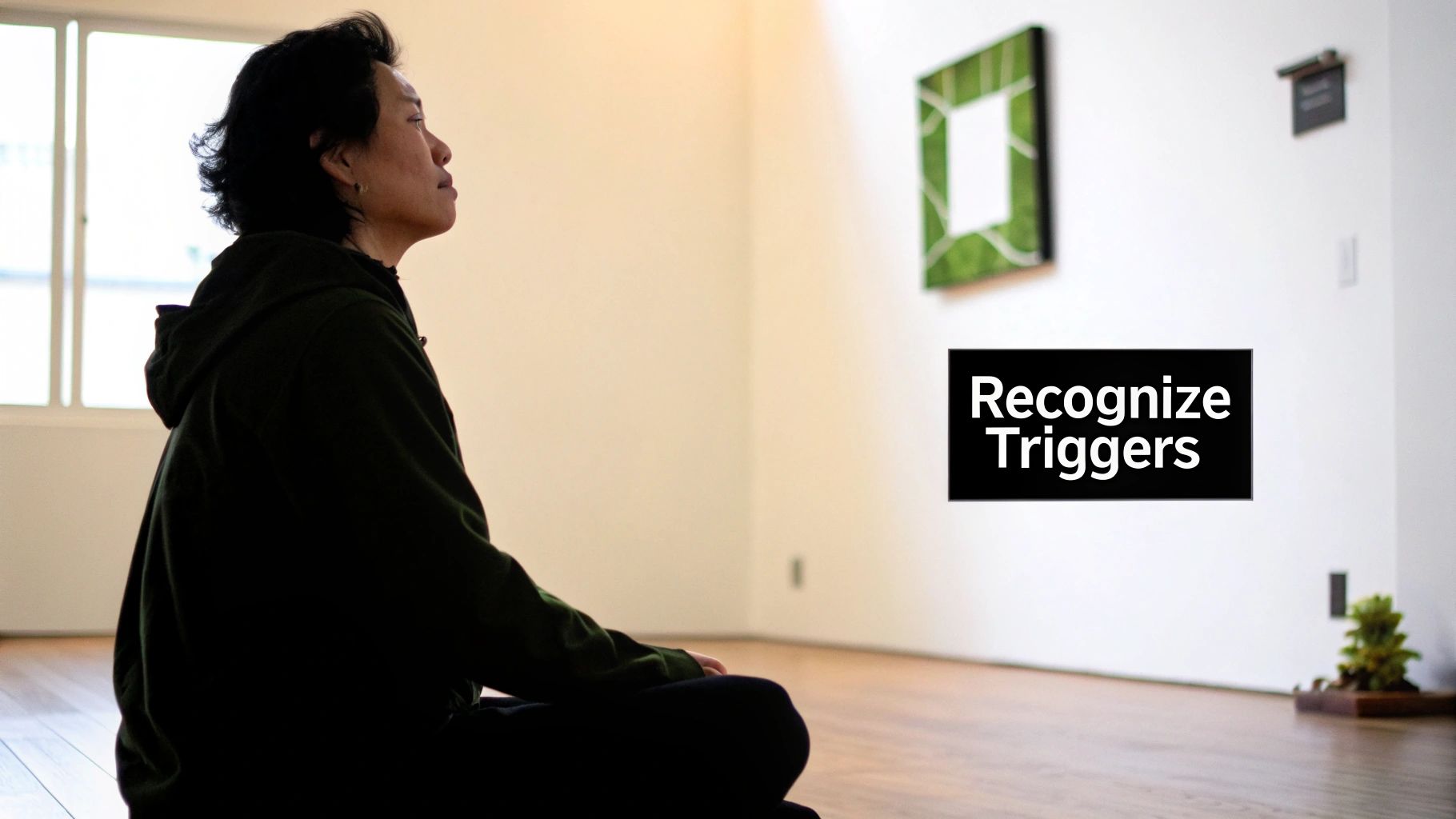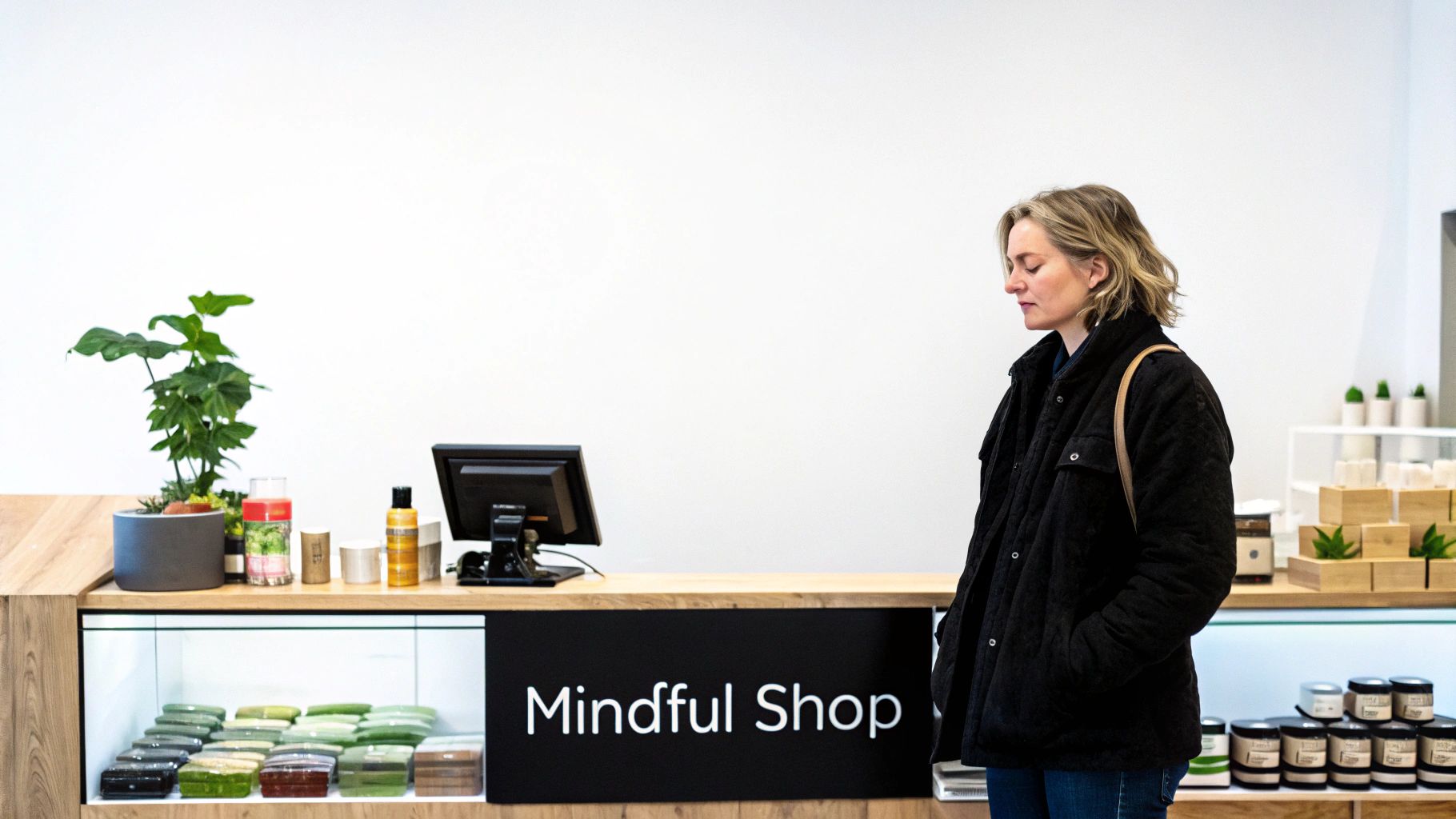
The Hidden Cost of Impulse Purchases

That enticing candy bar at the checkout, the flashing "limited-time offer" online, or the latest gadget a favorite influencer is promoting — we all experience the pull of impulse buys. These seemingly insignificant purchases accumulate, impacting our finances. This section explores the true cost of spontaneous spending and its effect on financial well-being.
One way to grasp this issue is by analyzing how common and costly these purchases are. In 2022, consumers spent an average of $314 per month on impulse buys, adding up to $3,768 per year. This demonstrates the considerable financial burden of impulse shopping. Furthermore, a staggering 89% of shoppers admit to making impulse purchases, with 60.7% spending $100 or more on a single item at least once. For a deeper dive into these statistics, visit: Impulse Buying Statistics.
This data highlights the need to understand how to avoid these often-regretted decisions. For tips on managing finances, consider: How to master your finances.
Understanding the Psychology of Impulse Buying
Impulse purchases frequently arise from a disconnect between our emotional desires and rational thought. Retailers exploit this, using strategies to activate our impulse-buying instincts. Carefully positioned products, attractive displays, and "limited-time offers" create a sense of urgency, bypassing logical decision-making. Therefore, understanding the psychology behind these tactics is essential for avoiding them.
The Long-Term Financial Impact
The combined effect of regular impulse buying can significantly impede financial progress. It can increase debt, hinder saving efforts, and create persistent financial strain. For instance, spending $5 daily on an unplanned coffee totals over $1,800 annually. This amount could have been invested or contributed to a larger financial objective. The emotional weight of regretting impulsive purchases also adds to financial stress.
Recognizing the Problem is the First Step
Acknowledging the impact of impulse purchases is the initial step towards mindful spending. By understanding the hidden costs associated with these seemingly small transactions, individuals can gain control of their finances and pursue their financial aspirations.
Mapping Your Personal Impulse Triggers

To effectively combat impulse buying, it's crucial to understand your personal triggers. This involves a process of self-discovery to identify your specific vulnerabilities. This means recognizing the emotional states and external factors that influence your spending habits. By mapping these triggers, you can create a personalized strategy for how to avoid impulse buying and gain control of your finances.
Identifying Emotional Spending Triggers
Certain emotional states can make you more vulnerable to impulse purchases. For instance, stress can lead to "retail therapy" as a coping mechanism. Feelings of boredom can also prompt unnecessary spending. Even positive emotions, like the excitement of a celebration, can trigger impulsive buys. Finally, social pressure to keep up with trends or fit in can also influence spending decisions.
Recognizing these emotional connections is the first step to breaking the cycle. Ask yourself some key questions: Do you shop to de-stress? Do you shop when you're bored? Do you buy things to celebrate or reward yourself? Do you shop to keep up with your friends or social circle?
Identifying these patterns helps you develop healthier coping mechanisms and address the root causes of your impulses.
Recognizing External Triggers
External factors, separate from your emotions, can also trigger impulse buys. These external triggers often involve marketing tactics designed to bypass rational thought. Think bright, colorful displays, enticing aromas, strategically placed items, and "limited-time offers." Retailers use these tactics to encourage unplanned spending. Understanding these tactics helps you make more conscious purchasing decisions.
Developing a Personal Trigger Map
A trigger map is a personalized tool to visualize your vulnerabilities to impulse spending. It helps you identify and track your emotional and environmental triggers, acting as your first line of defense. Documenting your purchases, along with your emotional state and the surrounding environment, allows you to see patterns. For example, are you more likely to make impulse purchases at the grocery store when you're hungry? Do you tend to overspend online when you're feeling down?
To help you identify and mitigate these triggers, let's explore some common impulse buying patterns:
The following table outlines common emotional and environmental triggers for impulse purchases, helping you identify your personal vulnerability patterns.
| Trigger Type | Examples | Warning Signs | Prevention Strategy |
|---|---|---|---|
| Emotional | Stress, Boredom, Loneliness, Happiness | Feeling overwhelmed, restless, or down | Practice mindfulness, find alternative activities like exercise or spending time with loved ones. |
| Environmental | Checkout displays, End-of-aisle promotions | Feeling tempted by visually appealing items | Create a shopping list and stick to it. Avoid browsing areas with tempting impulse buys. |
| Marketing Tactics | Limited-time offers, Flash sales | Feeling a sense of urgency | Research prices beforehand and set a budget. Don't be swayed by "limited-time" pressure. |
By consistently tracking your purchases and analyzing your trigger map, you can gain valuable insights into your spending habits. This awareness is key to developing personalized strategies and breaking free from reactive spending. Ultimately, this process helps you make more intentional choices with your money.
Transforming Shopping From Random to Strategic

Successfully managing your finances often hinges on how you approach daily spending. This means transitioning from reactive shopping habits to strategic, planned purchases. This section explores practical ways to curb impulse buying and cultivate more mindful spending. You'll learn how to create effective shopping lists, allocate your budget wisely, and develop personalized strategies for smarter purchasing decisions.
Creating Effective Shopping Lists
A well-structured shopping list is much more than just a memory aid. It's a vital tool in the fight against impulse buying. Think of it as a roadmap, guiding your purchases and preventing unplanned spending. This focused approach keeps you on track with essential items and helps you resist tempting displays and promotions. Organize your list by category (produce, dairy, etc.) to make your shopping trips more efficient.
Planning your meals for the week and basing your shopping list on those meals is another effective strategy. This approach helps reduce both food waste and those last-minute, impulse grocery purchases. By knowing exactly what you need, you're less likely to be swayed by enticing but unnecessary items.
Budget Allocation and Category-Based Purchasing
A clearly defined budget is crucial for strategic spending. This involves allocating specific amounts to different categories, such as groceries, entertainment, and clothing. This method allows for flexibility within each category while preventing overspending overall. Imagine dividing your money into separate envelopes—when an "envelope" is empty, spending in that category is finished for the month.
This "envelope" method reinforces budget limits and helps avoid impulse buys fueled by fleeting desires. Category-based purchasing simplifies decision-making by setting spending limits upfront. By pre-determining how much you can spend in each area, you’ll make more conscious choices about where your money goes.
Personalized Waiting Periods and Decision Rules
Implementing a waiting period for non-essential purchases can dramatically reduce impulse buying. This could be a 24-hour rule or even a 30-day rule, depending on the item's cost and your personal spending habits. This pause allows time to assess the item's true value and whether it aligns with your needs and budget. Often, the initial urge to buy fades with time, revealing a purchase as less essential than originally thought.
Creating decision rules provides a framework for evaluating potential purchases. For example, ask yourself: "Do I already own something similar?" or "Will this purchase support my long-term financial goals?" These rules offer a rational filter for spending decisions, helping you avoid purchases you’ll later regret.
Leveraging Digital Tools for Intentional Shopping
Technology can be a double-edged sword when it comes to spending. While online shopping offers convenience, it also exposes us to targeted ads and tempting promotions. However, using digital tools strategically can reinforce mindful spending habits. Unsubscribe from tempting marketing emails and disable push notifications from shopping apps to reduce exposure to spending triggers.
Consider using browser extensions that track your spending or even block certain websites. These tools create helpful friction in the purchasing journey, making it harder to make impulsive buys. By leveraging technology mindfully, you can strengthen your defenses against impulse spending and move closer to achieving your financial objectives.
Navigating the Digital Impulse Landscape

The online world has transformed how we shop, making impulse purchases easier than ever before. This section explores how digital environments, from e-commerce platforms to social media, encourage spontaneous spending. We'll examine how these tactics work and, crucially, how to avoid impulse buying in our increasingly digital lives. You might be interested in: Our sitemap for more information.
One-Click Purchasing and the Illusion of Convenience
One-click purchasing, while undeniably convenient, strips away the inherent friction of the traditional buying process. This friction – the time required to enter payment details and confirm the order – offers a crucial moment for reflection. This ease of purchase is a significant driver of online impulse buys.
Think of it like using a ride-sharing app like Uber or Lyft; the speed and simplicity can make it feel almost automatic. This often leads to more frequent, and sometimes unnecessary, rides. This frictionless experience significantly contributes to the challenges of avoiding impulse buys.
The Psychology of Countdown Timers and Limited-Time Offers
Countdown timers and limited-time offers inject a sense of urgency, compelling rapid decisions. This urgency plays on our fear of missing out (FOMO), often resulting in emotionally-driven rather than logically-considered purchases. These tactics circumvent rational thought.
They create pressure to buy before fully evaluating the need for the item or the affordability. This pressure can significantly weaken resistance to impulsive spending.
The Influence of Social Media on Impulse Buying
Social media platforms are fertile ground for impulse purchases. Influencer marketing and targeted advertising utilize social proof and personalized recommendations to entice us with products we might not actually require.
Another critical aspect is the demographic distribution of impulse buying. For example, 52% of millennials are reportedly more prone to impulse purchases than other generations. This is often attributed to platforms like Facebook and TikTok, which promote instant gratification and peer influence. Gen Z, conversely, favors platforms like TikTok for impulse shopping. Find more detailed statistics here. This social pressure adds another layer of complexity to the challenge of resisting impulse buys.
Reconfiguring Your Digital Environment for Mindful Spending
Resisting the digital push towards impulse buying requires restructuring your digital environment. Begin by managing notifications. Disabling shopping app notifications can minimize exposure to constant reminders about sales and new items. Unsubscribing from marketing emails similarly reduces the influx of tempting offers.
Consider installing browser extensions that block advertisements or prompt you to rethink purchases. These tools introduce a digital pause, encouraging more thoughtful spending. Implementing these small changes can significantly alter how you interact with online shopping environments. By introducing mindful friction and minimizing distractions, you regain control over your digital spending habits. This proactive approach empowers you to make conscious purchasing decisions and resist online impulse buying.
Mental Frameworks That Defeat Impulse Urges
Winning the fight against impulse buying often comes down to mindset. This means strategically developing mental defenses to counteract the urge to overspend. By understanding our own thought processes, we can create effective techniques to manage impulsive spending habits. This section explores powerful mental frameworks that can help you resist those tempting impulse buys.
Implementation Intentions: Planning for Temptation
Implementation intentions involve creating "if-then" plans to deal with potential triggers before they even strike. For example, "If I'm tempted to buy a new gadget, then I will wait 24 hours before making a decision." These pre-planned responses offer a clear course of action in moments of temptation, eliminating the need for spur-of-the-moment decisions.
This proactive approach helps you navigate difficult situations and maintain your financial goals. Having a plan in place makes it much easier to resist impulse buys and make rational purchasing decisions.
Reframing "Deals" and "Savings": Recognizing True Value
Retailers often use words like "deals" and "savings" to encourage purchases. Reframing how you perceive these offers can be incredibly effective. Instead of focusing on the perceived discount, ask yourself: "Do I truly need this, regardless of the sale?" and "Would I buy this at full price?"
This shifts the focus from the perceived savings to the item’s actual value and its role in your life. By critically evaluating the true value of a purchase, you avoid being swayed by clever marketing tactics. This allows you to make informed decisions based on need, rather than the allure of a discount.
Mindfulness and Consumption: Bringing Awareness to Spending
Mindfulness, when applied to shopping, involves paying close attention to your thoughts, feelings, and physical sensations as you shop. This awareness can help you differentiate between genuine needs and emotionally driven desires. Before clicking "buy," pause and reflect.
Ask yourself: "Why do I want this?" and "How will this purchase make me feel?" This moment of self-reflection can prevent unnecessary purchases and foster a healthier relationship with shopping. Understanding the mindset of online shoppers can also help you avoid impulse purchases. Consider these things customers look for when buying online.
Developing Personalized Mental Scripts: Navigating Temptation
Prepare mental scripts to navigate tricky shopping situations. For instance, if you’re tempted by a "limited-time offer," remind yourself: "These offers are designed to make me spend impulsively." These pre-planned responses offer a mental defense against common marketing strategies.
They empower you to make conscious, reasoned decisions, rather than succumbing to external pressures. By developing and practicing these scripts, you’ll strengthen your resistance to impulsive urges.
To further illustrate these techniques, let's examine a comparison of their effectiveness and implementation:
The following table compares different psychological methods for reducing impulse buying, outlining their effectiveness and ease of implementation.
Psychological Techniques Comparison
| Technique | How It Works | Effectiveness Rating | Difficulty Level | Best For |
|---|---|---|---|---|
| Implementation Intentions | Creating "if-then" plans to address triggers. | High | Easy | Planned Purchases |
| Reframing Deals | Evaluating the true need and value of an item. | Medium | Medium | Sale Shopping |
| Mindfulness | Paying attention to thoughts and feelings while shopping. | High | Medium | Emotional Shoppers |
| Mental Scripts | Preparing pre-planned responses to marketing tactics. | Medium | Easy | Online Shopping |
This table highlights that while some techniques, like Implementation Intentions, are easier to implement, others, like Mindfulness, require more practice but can be highly effective. Choosing the right technique, or combination of techniques, depends on your individual shopping habits and triggers.
Mastering the E-Commerce Minefield
Online shopping can make impulse buying incredibly easy. E-commerce platforms use clever design elements specifically to encourage quick purchases, often bypassing our rational decision-making. This section explores these tactics and offers strategies for navigating the online marketplace strategically, helping you resist impulsive spending.
Decoding Persuasive Design: How E-Commerce Sites Influence You
E-commerce sites employ a range of psychological tactics to encourage spending. Scarcity tactics, such as limited-time offers and low-stock warnings, create a sense of urgency. This often pushes shoppers to buy before fully considering the purchase. Personalized recommendations, powered by algorithms, suggest products based on your browsing history, which can further fuel impulse buys. Additionally, one-click ordering streamlines the buying process. This minimizes the time for reflection and increases the likelihood of impulsive decisions. These design elements are intentionally crafted to bypass rational thought.
The 24-Hour Rule: Your Digital Shopping Cart Savior
One effective method for combating online impulse buying is the 24-hour rule. Before clicking "buy," add the item to your cart and wait 24 hours. This waiting period allows you to evaluate the purchase critically and determine if it's a genuine need or a fleeting want. This simple strategy can be remarkably effective in reducing unnecessary online purchases. The pause also lets you consider whether the purchase aligns with your budget and long-term financial goals.
Building a Comparison Matrix: Unveiling the Best Value
Another helpful tool for informed decision-making is a comparison matrix. Before making a purchase, create a simple table listing competing products and their features, prices, and reviews. This structured approach helps you select the product that best fits your needs and budget, avoiding emotionally driven purchases. The matrix provides a clear visual representation of the various options, simplifying the process of identifying the best value.
Calculating True Value: Looking Beyond the Discount
Impulse buying is often driven by perceived deals. Developing a value calculation framework can help you look beyond the discount and evaluate a purchase's true cost. Consider the item's cost per use, its longevity, and potential resale value. A high-quality, durable item might be a better long-term investment than a cheaper, disposable alternative, even if the latter is on sale. Online impulse purchases make up a substantial 40% of all e-commerce spending. Furthermore, 67% of consumers admit to impulse buying items simply because they were discounted. Find more detailed statistics here.
Setting Digital Boundaries: Taming Deal Notifications
Deal notifications can be a significant trigger for impulse buys. Instead of disabling them completely, reframe them as information-gathering tools. Use them to research price trends and compare offers, but resist clicking through to the product page until you’ve decided to buy. This approach lets you benefit from deal information without feeling pressured to purchase immediately. By establishing these digital boundaries, you can control technology's influence while still working towards your financial objectives.
Building a Financially Empowered Relationship With Shopping
Building a strong financial foundation involves more than just avoiding impulse buys. It's about cultivating a healthy and sustainable relationship with shopping. This means finding genuine satisfaction beyond material possessions, reviewing spending habits, and rewarding yourself for financial milestones. It's a journey of transforming your mindset about spending and aligning your consumption with your values and long-term goals.
Finding Fulfillment Beyond Purchases
True fulfillment rarely comes from a shopping bag. While acquiring new things can provide a temporary high, lasting happiness often stems from experiences, relationships, and personal growth. Consider exploring hobbies, spending quality time with loved ones, or pursuing personal development. These activities offer a more sustainable sense of satisfaction than material goods and can significantly reduce the urge to shop impulsively.
Implementing Regular Spending Reviews
Regularly reviewing your spending is crucial for maintaining financial health. This doesn't have to be a complicated process. Many banking apps, such as Mint, provide clear visualizations of your spending patterns. Use these tools to identify areas where you might be overspending. Even a quick monthly check-in can reveal valuable insights and reinforce positive spending habits, keeping you on track with your financial objectives. You might be interested in the FindTopTrends Product Dimensions Sitemap for more information on product categories and trends.
Creating a Reward System for Financial Milestones
Celebrating financial achievements can be a powerful motivator. Establish a reward system for reaching specific financial goals. These rewards don't have to be extravagant; they can be simple pleasures like a special meal or a day trip. The key is to associate positive experiences with financial responsibility, reinforcing healthy habits. This positive reinforcement makes the process of achieving financial goals more enjoyable and sustainable.
Learning From Spending Lapses: Embracing the Journey
Occasional slip-ups are a natural part of the process. Don't let them derail your progress. Instead, view these lapses as learning opportunities. Analyze what triggered the impulse purchase and strategize how you can prevent it in the future. This self-compassionate approach fosters resilience and promotes long-term change. Remember, it's about progress, not perfection.
Reframing Pleasure From Purchases: Focusing on Value and Intention
Shifting your perspective on purchases can significantly impact your spending habits. Instead of finding pleasure solely in the act of buying, focus on the value and intention behind each purchase. Ask yourself: "Will this item truly enhance my life?" and "Does it align with my values and goals?" This mindful approach helps you avoid purchases driven by fleeting desires, leading to more fulfilling and intentional spending.
Developing a Personal Philosophy of Consumption
Developing a personal philosophy of consumption is a crucial step towards financial empowerment. This involves defining your values around spending and creating guiding principles for your purchasing decisions. This philosophy becomes your internal compass, directing your financial choices and ensuring they align with your overall life goals. It helps you make conscious decisions about what you buy, why you buy it, and how it contributes to your life.
Are you ready to take control of your spending and achieve your financial goals? Explore the curated selection of high-quality products at FindTopTrends and discover how mindful shopping can enhance your life.





